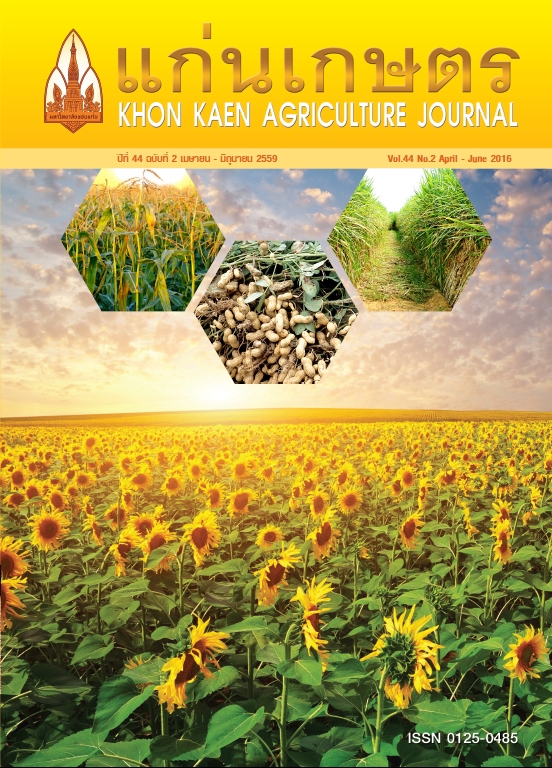ความหลากหลายของมดในพื้นที่ที่มีการใช้ประโยชน์ที่แตกต่างกันในมหาวิทยาลัยเกษตรศาสตร์วิทยาเขตกำแพงแสน
Main Article Content
บทคัดย่อ
ศึกษาความหลากหลายของมดในพื้นที่ที่มีการใช้ประโยชน์ที่แตกต่างกัน ในมหาวิทยาลัยเกษตรศาสตร์ วิทยาเขตกำแพงแสน 3 พื้นที่ ได้แก่ บริเวณเคหสถาน พื้นที่รกร้าง และสวนมะม่วง ระหว่างเดือน มกราคมถึงมีนาคม พ.ศ. 2558 เก็บข้อมูลมดจากกับดักหลุมโดยใช้เหยื่อล่อคือน้ำผึ้งและทูน่า พบความหลากชนิดของมดในพื้นที่ 20 สกุล 28 ชนิด และ 4 วงศ์ย่อย คือ Dolichoderinae (11%), Formicinae (29%), Myrmicinae (46%) และ Ponerinae (14%) มดที่สามารถปรับตัว อาศัยได้ทุกพื้นที่คือ Diacamma rugosum Le Guillou (Ponerinae), Monomorium pharaonis Linnaeus (Myrmicinae) และ Paratrechina longicornis Latreille (Formicinae) มดที่มีความจำเพาะเจาะจงต่อพื้นที่รกร้าง คือ Polyrhachis laevissima F. Smith (Formicinae) และ Pheidole sp.2 (Myrmicinae) บริเวณเคหสถานคือ Meranoplus bicolor Guérin-Méneville (Myrmicinae) ดัชนีความหลากหลาย (Shanon - Wiener Index) ดัชนีความสม่ำเสมอ (Pielou’s evenness) ความคล้ายคลึงกัน (ANOSIM) ในพื้นที่ศึกษามีค่าต่ำสุดบริเวณเคหสถานความคล้ายคลึงระหว่างชนิดของมดในพื้นที่รกร้าง และสวนมะม่วงมีค่าสูงแสดงให้เห็นว่าความหลากชนิดและองค์ประกอบของชนิดมดแตกต่างกันขึ้นกับการใช้ประโยชน์ของพื้นที่ที่แตกต่างกัน
Article Details
เอกสารอ้างอิง
เดชา วิวัฒน์วิทยา และ วียะวัฒน์ ใจตรง. 2544. คู่มือจัดจำแนกมดบริเวณอุทยานแห่งชาติเขาใหญ่. ภาควิชาชีววิทยาป่าไม้ คณะวนศาสตร์ มหาวิทยาลัยเกษตรศาสตร์, กรุงเทพฯ.
รุ้งนภา พูลจำปา. 2545. การใช้มดเป็นตัวบ่งชี้สังคมพืชในบริเวณอุทยานแห่งชาติเขาใหญ่. วิทยานิพนธ์ปริญญาวิทยาศาสตรมหาบัณฑิต สาขาชีววิทยาป่าไม้ มหาวิทยาลัยเกษตรศาสตร์, กรุงเทพฯ.
Bolton, B. 1994. Identification guide to the ant genera of the world. Harvard University Press.
Bruehl, C. A., M. Mohamed, and K. E. Linsenmair. 1999. Altitudinal distribution of leaf litter ants along a transect in primary forests on Mount Kinabalu, Sabah, Malaysia. J. Trop. Ecol. 15: 265-277.
Drescher J, N. Blüthgen, and H. Feldhaar. 2007. Population structure and intraspecific aggression in the invasive ant species Anoplolepis gracilipes in Malaysian Borneo. Mol. Ecol. 16: 1453-1465.
Farnsworth, E.J. 1993: Interactions between Cecropia peltata L. (Moraceae) and Paratrechina longicornis(Latrielle) (Formicidae) at a sinkhole in the Guanica dry forest, Puerto Rico. Caribb. J. Sci. 29: 124-125.
Gadagkar, R., P. Nair, K. Chandrashekara, and D. M. Bhat. 1993. Ant species richness and diversity in some selected localities in Western Ghats, India. Hexapoda. 5(2): 79-94.
Gomez, C., D. Casellas, J. Oliveras, and J. M. Bas. 2003. Structure of ground-foraging ant assemblages in relation to land-use change in the Northwestern Mediterranean region. Biodivers. Conserv. 12: 2135-2146.
King, J. R., A. N. Andersen, and A. D. Cutter. 1998. Ants as bioindicators of habitat disturbance: validation of the functional group model for Australia’s humid tropics. Biodivers. Conserv. 7: 1627-1638.
Mezger, D., and M. Pfeiffer. 2011. Influence of the arrival of Anoplolepis gracilipes (Hymenoptera: Formicidae) on the composition of an ant community in a clearing in Gunung Mulu national park, Sarawak, Malaysia. Asian Myrmecology. 4: 89-98.
Pielou, E.C. 1966. Shannon’s formula as a measure of species diversity: its use and misuse’. Am. Nat. 100: 463-465
Patterson, R. S. 1994. Biological control of introduced ant species, P. 293-304. In: D. F. Williams, ed. Exotic Ants: Biology Impact and Control of Introduced Species. Westview Press. United States of America.
Peck, L. S., B. Mcquaid, and C. L. Campbell. 1998. Using ant species (Hymenoptera: Formicidae) as a biological indicator of agroecosystem condition. Environ. Entomol. 27(5): 1102-1110.
Oksanen, J., F. G. Blanchet, R. Kindt, P. Legendre, P. R. Minchin, R. B. O’Hara, G. L. Simpson, P. Solymos, M. H. H. Stevens, and H. Wagner. 2015. vegan: community ecology package. R Package Version 2.2-1. Accessed: http://vegan.r-forge.r-project.org. Accessed May. 15, 2015.
R Development Core Term. 2015. R: a language and environment for statistical computing, Version 3.1.3 (2015-03-09) R foundation for statistical computing. Accessed: http://goo.gl/gcszp3. Accessed Mar. 10, 2015.
Sarty, M., K.L. Abbott, and P.J. Lester. 2007. Community level impacts of an ant invader and food mediated coexistence. Insect Soc. 54(2): 166-173.
Shannon, CE., and W. Weaver. 1964. The mathematical theory of communication. University of Illinois Press, Urbana.
Shattuck, S. 2000. Australian ants: their biology and identification. CSIRO publishing. Smith, M. R. 1965. House-infesting ants of the eastern United States; their recognition, biology, and economic importance. USDA Technical Bulletin 1326. 105 p.
Wetterer, J.K. 2008. Worldwide spread of the longhorn crazy ant, Paratrechina Longicornis (Hymenoptera: Formicidae). Myrmecological News. 11: 137-149.
Wetterer, J. K. 2015. Geographic origin and spread of cosmopolitan ants (Hymenoptera: Formicidae). Halteres. 6: 66-78
Yamane, S., T. Itino, and A. R. Nona. 1996. Ground ant fauna in a Bornean dipterocarp forest. The Raffles Bulletin of Zoology. 44(1): 253-262.


